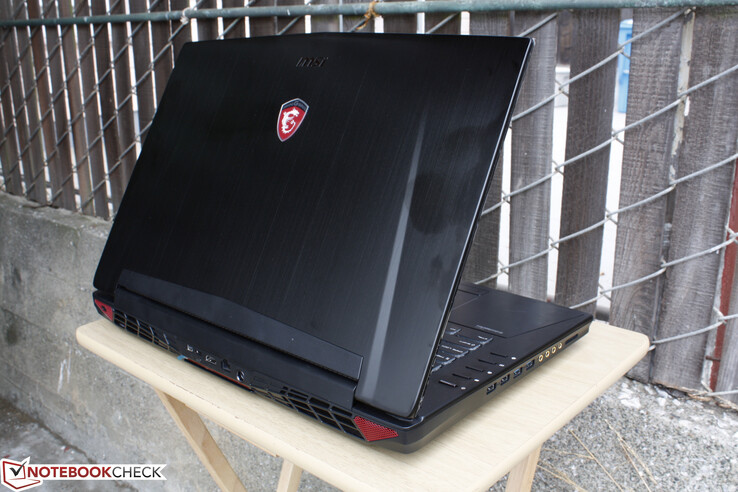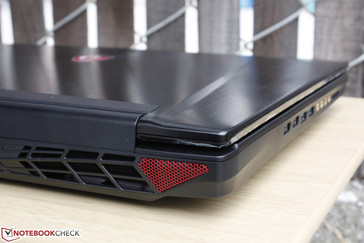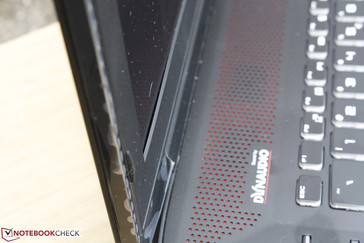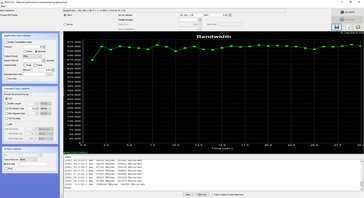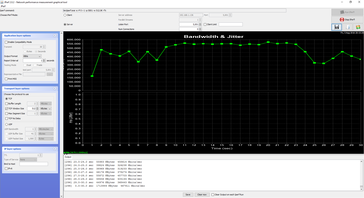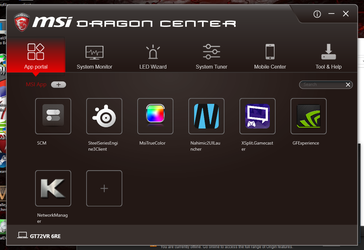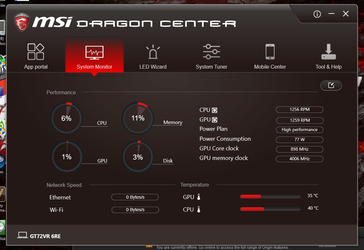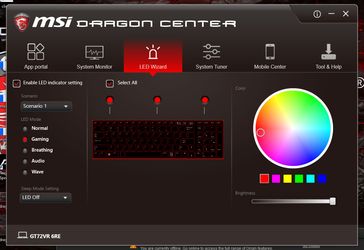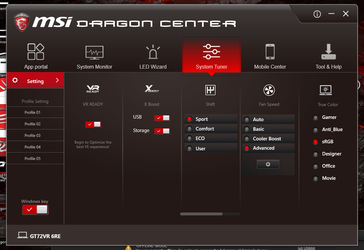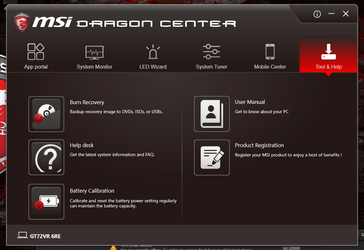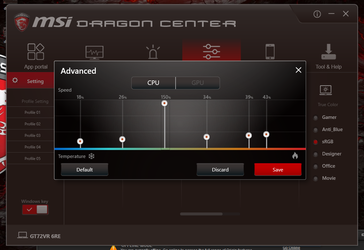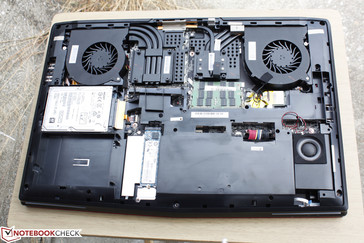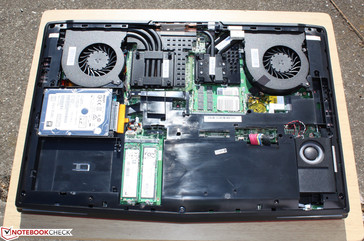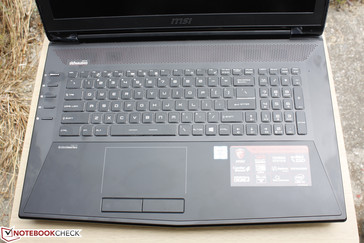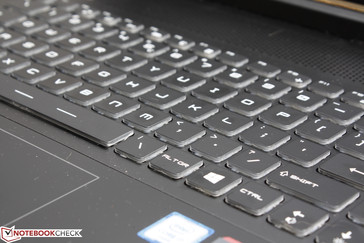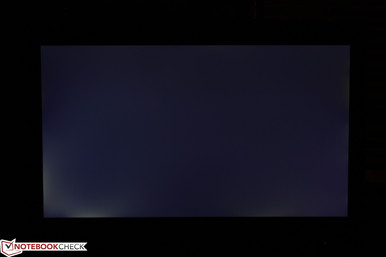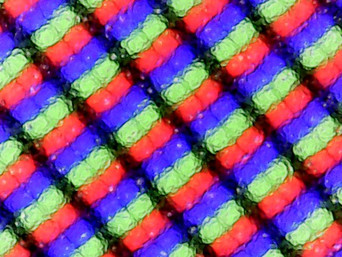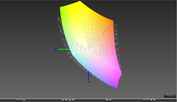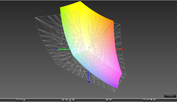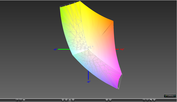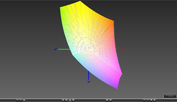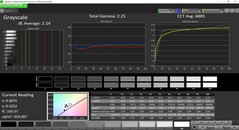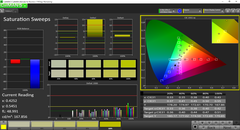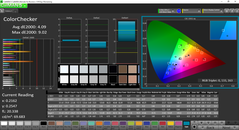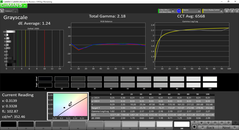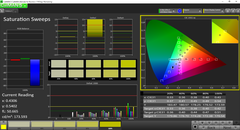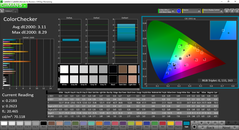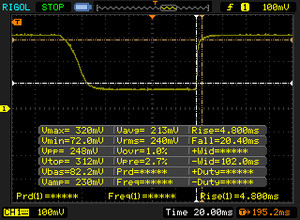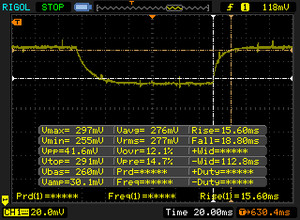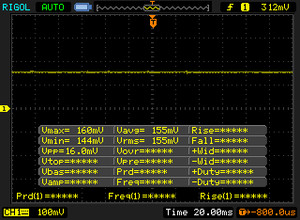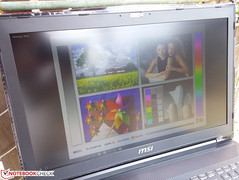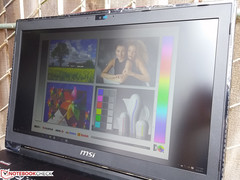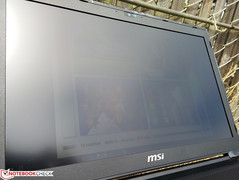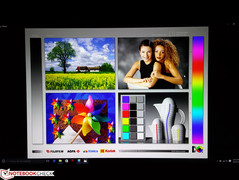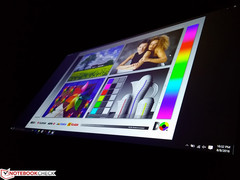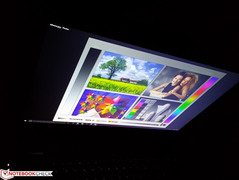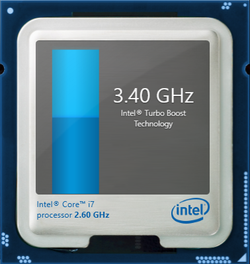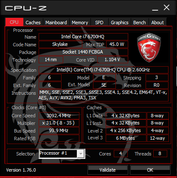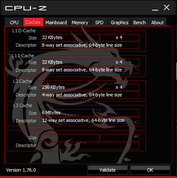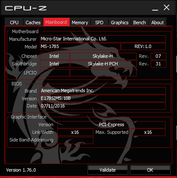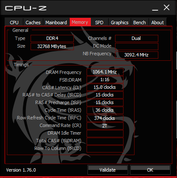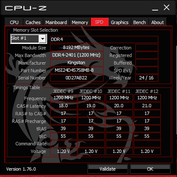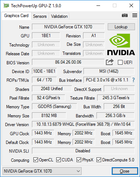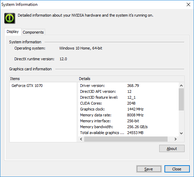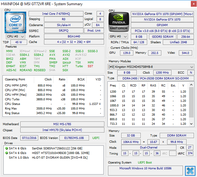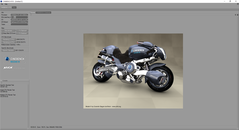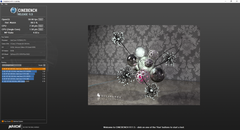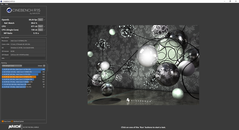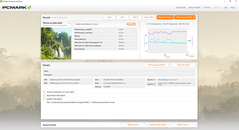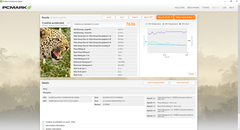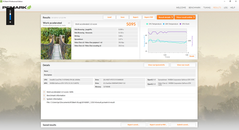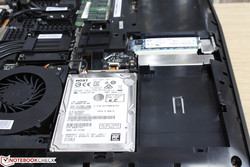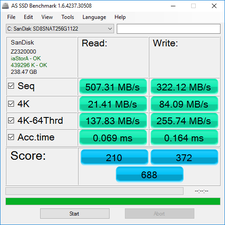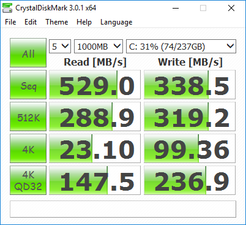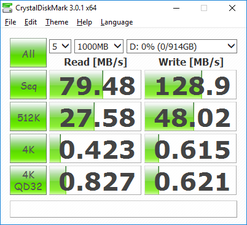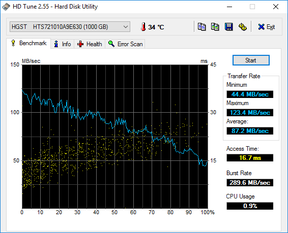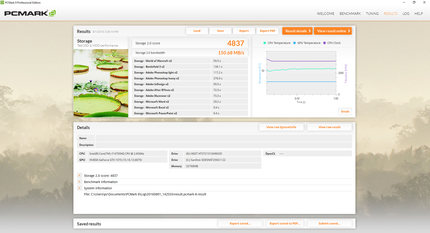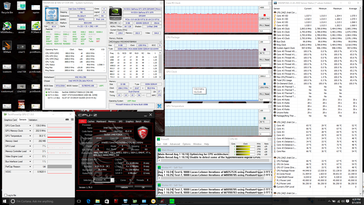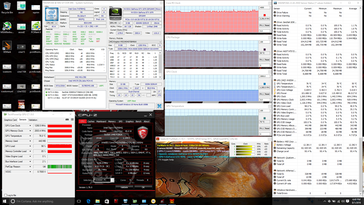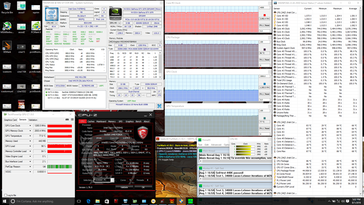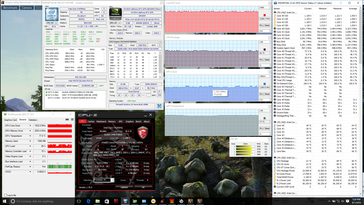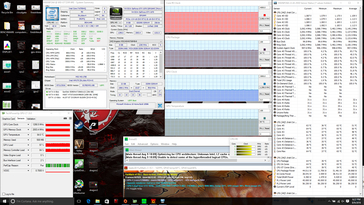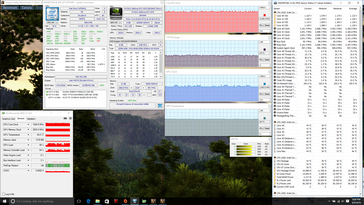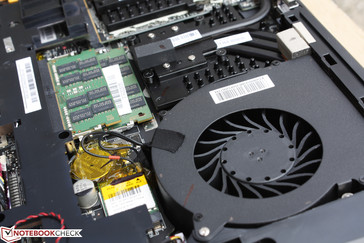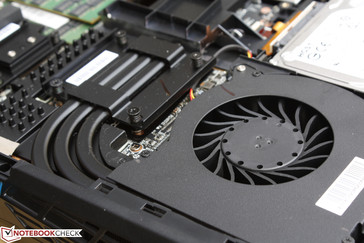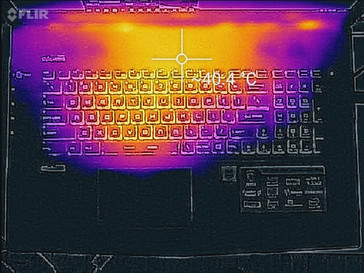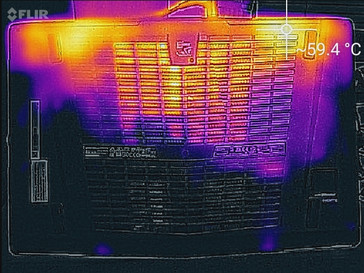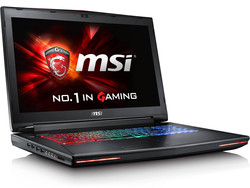MSI GT72VR 6RE-015US Notebook Review

MSI hit a home run with the GT72 and it continues to be one of the best 17.3-inch gaming notebooks available according to our Top 10 list. The following GT72S was a relatively minor update with small visual changes to the keyboard keys and some internal upgrades including Skylake, DDR4, and Thunderbolt 3.
Move one step up from the GT72S and we get the new GT72VR, which carries the same design and features as its older sibling but with a couple of updates yet again. Unlike the GT72S, however, these small changes have potentially larger implications to the gaming experience. Aside from the headline-grabbing Pascal GPU options, this latest refresh includes an optional 120 Hz FHD display with a redesigned Dragon Tuner system utility software. Nonetheless, MSI has also removed a few features from the GT72VR as well. The result should help the GT72 series maintain its top spot against the likes of the Dell Alienware and Asus ROG series.
We recommend checking out our previous reviews on the GT72S and GT72 since the chassis, connectivity features, keyboard, and serviceability are largely identical between them.
Case
We don't blame MSI for sticking with the tried and true GT72 chassis. While the proper GT73VR successor is available with SLI options, the GT72 has proven itself to be a challenge for other manufacturers to topple in terms of stability and serviceability even after being in market for more than two years. Thus, there is little reason to drop the chassis entirely.
The base is sturdy from top to bottom with excellent rigidity down the center of the keyboard and around the corners. The lid is still the weakest portion of the notebook as its corners and center are susceptible to bending and warping, though this is common on larger notebooks. The corners of the screen where the inner bezel meets the edge are also not completely flat with an ugly gap as shown in our image below. Another nitpick is the narrow and thin rear ventilation grilles that can be easily broken due to the way they are designed. Otherwise, there's very little to not like about both the design and quality of the GT72.
The downside to having such a solid, accessible, and feature-heavy notebook is its size. At about 48 mm, the GT72S is still one of the thickest gaming notebooks for its size class. Even the Eurocom DLX7 and its desktop-class Skylake CPU and GTX 980 is thinner, though it is also simultaneously a few hundred grams heavier. Indeed, the GT72 doesn't feel as dense as some of its competitors and this is evident through the ample air space between the bottom cover and the internals it is protecting.
Connectivity
Users will find the same ports and options as on the GT72S with one major change: Thunderbolt 3 has been removed in favor of a simple USB Type-C port. This bolsters the value of the GT73VR and further positions in the GT72 series as a "lower enthusiast" solution moving forward. The system still carries more USB and audio ports than most competing systems including the Alienware 17 and Asus ROG G701. The mDP port will not output to a compatible display unlike on the EVGA SC17.
(September 15, 2016 correction: MSI has informed us that its Pascal GT and GE series can indeed output to compatible G-Sync displays via HDMI, mDP, and Thunderbolt 3 if available.)
SD Card Reader
Transfer rates from the SD reader are double that of the Alienware 17 R3 with our Toshiba Exceria Pro SDXC 64 GB UHS-II reference card. Recent high-end multimedia notebooks like the XPS 15 have SD readers with similar transfer rates as our MSI.
| SD Card Reader | |
| average JPG Copy Test (av. of 3 runs) | |
| MSI GT72VR 6RE-015US | |
| Dell XPS 15-9550 i7 | |
| Alienware 17 R3 (A17-9935) | |
| maximum AS SSD Seq Read Test (1GB) | |
| Dell XPS 15-9550 i7 | |
| MSI GT72VR 6RE-015US | |
| Alienware 17 R3 (A17-9935) | |
Communication
WLAN is provided by a dual-band Killer 1535 (QCA617) M.2 module with MU-MIMO and beamforming capable of theoretical transfer rates of up to 867 Mbps. A real-world test shows an average stable transfer rate of about 544 Mbps when standing one meter away from our Linksys EA8500 test router.
| Networking | |
| WiFi Speed Client 1m | |
| WiFi Speed Server 1m |
Dragon Software
MSI has overhauled its systems utility software for the better as the older version was clunky, full-screen, and ultimately unintuitive. The all-in-one Dragon Center is a one-step stop to check on system vitals, gaming settings and profiles, mobile connection via the MSI app, keyboard behavior, Windows recovery, and fan control. Users can manually set separate fan speeds for the CPU and GPU based on six pre-defined core temperatures each. Oddly, the utility does not explicitly state exactly what temperatures these pre-defined settings are and only provides a vague color scale as shown below. Setting the fan speeds to zero will not stop the fans completely.
Accessories
Included extras are limited to pamphlets, a large cleaning cloth, and a Quick Start guide. Branded G Series accessories are available optionally, but the system loses support for Thunderbolt 3-enabled docking stations and displays.
Maintenance
A quick look at the internals of the GT72VR shows no major changes compared to the GT72S. The cooling system consists of the same dual fans and seven heat pipes for both the CPU and GPU. Note that the heat pipes are not shared evenly across the processors and that the fans operate independently; MSI tells us this should allow for more overclocking potential out of the GPU since it's cooling is not tied to the CPU.
Most of the M.2 slots have been removed to effectively kill RAID support.
Warranty
The standard one-year limited warranty from the manufacturer applies. Users who register their notebooks with MSI will receive another 12 months of coverage with accidental damage protection at no additional cost. CUKUSA covers any components modified or added by the retailer for up to three years including the HDD and RAM.
Input Devices
Keyboard & Touchpad
No major changes have been made to the already excellent Steelseries keyboard (34.5 x 10.5 cm) or touchpad (11.25 x 6.5 cm). We're not fans of the flushed edges and corners of the touchpad as its lack of any tactile indicators make it easy to move out of the touch-sensitive surface. Users can customize the RGB backlight in three separate sections of the keyboard in three light level intensities.
The column of auxiliary keys (Turbo Fan, XSplit, SteelSeries) return with the manual GPU switch button replaced by a display on/off toggle. Competing models like the Aorus X7 or Alienware 17 offer customizable Macro keys to edge out the MSI in terms of keyboard options and features.
Display
Our test configuration is equipped with a 1080p screen that promises 5 ms white-to-black response time, G-Sync, and a 94 percent NTSC color gamut. According to MSI, its GT72VR is the first notebook to offer this entire set of features at a consumer level. The 4K UHD configuration does not currently offer the higher refresh rate and will likely be slightly different in terms of response times and color coverage as well, so our data below reflects only the 1080p option.
Subjectively, the screen exhibits no graininess or screen-door issues that can sometimes be more noticeable on matte displays. A quick search for its LG Philips LGD046E panel name shows no other notebooks in our database sporting the exact same panel. Backlight brightness is an average 327 nits with a measured contrast ratio of about 1000:1 to be in line with most other high-end 17-inch gaming systems.
There is slight backlight bleeding near the bottom corner of the display on our test unit that is only noticeable during movie playback and under dark ambient conditions.
(August 22, 2016 correction: Our test model is equipped with a 60 Hz panel and not a 120 Hz panel as previously mentioned. The 120 Hz/5 ms panel is still a separate option for the GT72VR)
| |||||||||||||||||||||||||
Brightness Distribution: 89 %
Center on Battery: 348.7 cd/m²
Contrast: 1080:1 (Black: 0.323 cd/m²)
ΔE ColorChecker Calman: 4.09 | ∀{0.5-29.43 Ø4.77}
ΔE Greyscale Calman: 2.14 | ∀{0.09-98 Ø5}
86.5% sRGB (Argyll 1.6.3 3D)
56.9% AdobeRGB 1998 (Argyll 1.6.3 3D)
63.4% AdobeRGB 1998 (Argyll 3D)
86.7% sRGB (Argyll 3D)
68.3% Display P3 (Argyll 3D)
Gamma: 2.25
CCT: 6885 K
| MSI GT72VR 6RE-015US LG Philips LGD046E, IPS, 17.3", 1920x1080 | Asus G701VO-CS74K IPS, 17.3", 1920x1080 | Acer Predator 17 G9-792-71EF AU Optronics B173ZAN01.0 (AUO109B), IPS, 17.3", 3840x2160 | Alienware 17 R3 (A17-9935) CV69H_173WF4 (LGD0459), IPS, 17.3", 1920x1080 | MSI GT72S 6QF Name: LG Philips LP173WF4-SPF1, ID: LGD0469, IPS, 17.3", 1920x1080 | |
|---|---|---|---|---|---|
| Display | 1% | 33% | -3% | -1% | |
| Display P3 Coverage (%) | 68.3 | 68.8 1% | 86.9 27% | 66.9 -2% | 67.6 -1% |
| sRGB Coverage (%) | 86.7 | 87.7 1% | 100 15% | 83.9 -3% | 86.1 -1% |
| AdobeRGB 1998 Coverage (%) | 63.4 | 64.1 1% | 99.6 57% | 61.4 -3% | 63 -1% |
| Response Times | 5% | -17% | 7% | -20% | |
| Response Time Grey 50% / Grey 80% * (ms) | 34.4 ? | 29.2 ? 15% | 42 ? -22% | 33 ? 4% | 43 ? -25% |
| Response Time Black / White * (ms) | 25.2 ? | 26.4 ? -5% | 28 ? -11% | 23 ? 9% | 29 ? -15% |
| PWM Frequency (Hz) | |||||
| Screen | -9% | -4% | -17% | 1% | |
| Brightness middle (cd/m²) | 348.7 | 368.1 6% | 370 6% | 360 3% | 356.7 2% |
| Brightness (cd/m²) | 327 | 349 7% | 340 4% | 336 3% | 326 0% |
| Brightness Distribution (%) | 89 | 86 -3% | 88 -1% | 90 1% | 85 -4% |
| Black Level * (cd/m²) | 0.323 | 0.365 -13% | 0.42 -30% | 0.44 -36% | 0.282 13% |
| Contrast (:1) | 1080 | 1008 -7% | 881 -18% | 818 -24% | 1265 17% |
| Colorchecker dE 2000 * | 4.09 | 4.16 -2% | 3.56 13% | 4.76 -16% | 4.16 -2% |
| Colorchecker dE 2000 max. * | 9.02 | 8.7 4% | 5.86 35% | 10.8 -20% | |
| Greyscale dE 2000 * | 2.14 | 3.86 -80% | 4.79 -124% | 3.69 -72% | 2.47 -15% |
| Gamma | 2.25 98% | 2.19 100% | 2.31 95% | 2.24 98% | 2.29 96% |
| CCT | 6885 94% | 6892 94% | 6352 102% | 6091 107% | 6860 95% |
| Color Space (Percent of AdobeRGB 1998) (%) | 56.9 | 57.6 1% | 88 55% | 55 -3% | 56 -2% |
| Color Space (Percent of sRGB) (%) | 86.5 | 87.6 1% | 100 16% | 84 -3% | 85 -2% |
| Total Average (Program / Settings) | -1% /
-5% | 4% /
1% | -4% /
-11% | -7% /
-3% |
* ... smaller is better
Color coverage is approximately 87 percent and 57 percent of the sRGB and AdobeRGB standards, respectively, when the display is set to sRGB mode through the Dragon Center utility. This is indicative of a high quality panel as most mainstream IPS displays have far narrower color gamuts in the 60 percent sRGB range. A small handful of gaming notebooks and Clevo barebones offer full sRGB coverage to appeal to digital artists, but color accuracy is not typically a priority for dedicated gaming systems like the GT72VR.
According to MSI, their gaming systems come pre-calibrated and our measurements with an X-Rite spectrophotometer show accurate colors and grayscale out-of-the-box without any end-user calibration required. Nonetheless, we were able to improve the display and its RGB Balance even further with a quick calibration as shown below. Colors become increasingly inaccurate the higher the saturation level due to the panel's imperfect sRGB coverage.
Display Response Times
| ↔ Response Time Black to White | ||
|---|---|---|
| 25.2 ms ... rise ↗ and fall ↘ combined | ↗ 4.8 ms rise | |
| ↘ 20.4 ms fall | ||
| The screen shows relatively slow response rates in our tests and may be too slow for gamers. In comparison, all tested devices range from 0.1 (minimum) to 240 (maximum) ms. » 60 % of all devices are better. This means that the measured response time is worse than the average of all tested devices (20.2 ms). | ||
| ↔ Response Time 50% Grey to 80% Grey | ||
| 34.4 ms ... rise ↗ and fall ↘ combined | ↗ 15.6 ms rise | |
| ↘ 18.8 ms fall | ||
| The screen shows slow response rates in our tests and will be unsatisfactory for gamers. In comparison, all tested devices range from 0.165 (minimum) to 636 (maximum) ms. » 47 % of all devices are better. This means that the measured response time is similar to the average of all tested devices (31.6 ms). | ||
Screen Flickering / PWM (Pulse-Width Modulation)
| Screen flickering / PWM not detected | |||
In comparison: 53 % of all tested devices do not use PWM to dim the display. If PWM was detected, an average of 8083 (minimum: 5 - maximum: 343500) Hz was measured. | |||
Outdoor visibility is average at best. The backlight is more than sufficient for indoor conditions, but it was not designed to overcome sunlight or daylight. The matte panel, wide IPS angles, and 180-degree hinges all help in reducing glare as much as possible.
Performance
Processor options remain the same as it was on the GT72S with a range of soldered Core i7 mobile Skylake options. The fact that gaming manufacturers are refreshing their lineups with Pascal without waiting on Kaby Lake first suggests that proper Kaby Lake gaming systems may not arrive until Q1 2017 at the very earliest. It's a shame that this MSI refresh does not offer desktop-class Skylake options like on a small number of Clevo barebones. System RAM remains unchanged at up to 64 GB DDR4 across four SODIMM slots, but maximum operating frequency has been upgraded to 2400 MHz.
Graphics options are available from the GTX 1060 up to the GTX 1070 in the upgradeable MXM form factor. Users who wish for SLI will need to make the jump to the GT73VR (up to GTX 1070/1080 SLI or a single GTX 1080) or the new Titan GT83VR (up to GTX 1080 SLI). As previously mentioned, MSI has removed any manual graphics switching for this GT72VR update.
Processor
Raw CPU performance from the Core i7-6700HQ has been well documented in our database. Its multi-core performance in the GT72VR is essentially on par with the i7-6820HK and older Broadwell i7-5700HQ as expected. Unfortunately, its single-core performance is lower than anticipated according to CineBench benchmarks. A closer look at its Turbo Boost shows that the processor can only maintain a maximum Turbo Boost of 3.4 GHz compared to its advertised 3.5 GHz for single-threaded workloads. The desktop-class i7-6700K outperforms the i7-6700HQ by about 20 to 30 percent according to the same benchmarks.
See our dedicated CPU page on the Core i7-6700HQ for more technical details and benchmark comparisons.
| Cinebench R15 | |
| CPU Single 64Bit (sort by value) | |
| MSI GT72VR 6RE-015US | |
| DogHouse Systems Mobius SS | |
| Asus G701VO-CS74K | |
| MSI GE62 2QC-468XPL | |
| Toshiba Satellite S70-B-106 | |
| Lenovo ThinkPad P40 Yoga 20GQ-000EUS | |
| CPU Multi 64Bit (sort by value) | |
| MSI GT72VR 6RE-015US | |
| DogHouse Systems Mobius SS | |
| Asus G701VO-CS74K | |
| MSI GE62 2QC-468XPL | |
| Toshiba Satellite S70-B-106 | |
| Lenovo ThinkPad P40 Yoga 20GQ-000EUS | |
| Cinebench R11.5 | |
| CPU Single 64Bit (sort by value) | |
| MSI GT72VR 6RE-015US | |
| DogHouse Systems Mobius SS | |
| Asus G701VO-CS74K | |
| MSI GE62 2QC-468XPL | |
| Toshiba Satellite S70-B-106 | |
| Lenovo ThinkPad P40 Yoga 20GQ-000EUS | |
| CPU Multi 64Bit (sort by value) | |
| MSI GT72VR 6RE-015US | |
| DogHouse Systems Mobius SS | |
| Asus G701VO-CS74K | |
| MSI GE62 2QC-468XPL | |
| Toshiba Satellite S70-B-106 | |
| Lenovo ThinkPad P40 Yoga 20GQ-000EUS | |
| Cinebench R10 | |
| Rendering Multiple CPUs 32Bit (sort by value) | |
| MSI GT72VR 6RE-015US | |
| DogHouse Systems Mobius SS | |
| Asus G701VO-CS74K | |
| MSI GE62 2QC-468XPL | |
| Lenovo ThinkPad P40 Yoga 20GQ-000EUS | |
| Rendering Single 32Bit (sort by value) | |
| MSI GT72VR 6RE-015US | |
| DogHouse Systems Mobius SS | |
| Asus G701VO-CS74K | |
| MSI GE62 2QC-468XPL | |
| Lenovo ThinkPad P40 Yoga 20GQ-000EUS | |
| wPrime 2.10 - 1024m (sort by value) | |
| MSI GT72VR 6RE-015US | |
| DogHouse Systems Mobius SS | |
| Asus G701VO-CS74K | |
| MSI GE62 2QC-468XPL | |
| Lenovo ThinkPad P40 Yoga 20GQ-000EUS | |
| Super Pi Mod 1.5 XS 32M - 32M (sort by value) | |
| MSI GT72VR 6RE-015US | |
| DogHouse Systems Mobius SS | |
| Asus G701VO-CS74K | |
| MSI GE62 2QC-468XPL | |
| Lenovo ThinkPad P40 Yoga 20GQ-000EUS | |
* ... smaller is better
System Performance
PCMark 8 ranks our system in the same ballpark as previous generation enthusiast-level gaming notebooks including the Asus G701 and Eurocom DLX7. Thus, while the GPU may be much more powerful, the GT72VR is not significantly faster than the competition for day-to-day workloads.
We experienced no notable hardware or software issues during our time with the GT72VR test unit.
| PCMark 8 | |
| Home Score Accelerated v2 (sort by value) | |
| MSI GT72VR 6RE-015US | |
| Asus G701VO-CS74K | |
| Eurocom Sky DLX7 | |
| Alienware 17 R2 | |
| Acer Predator 17 G9-791-75PV | |
| Work Score Accelerated v2 (sort by value) | |
| MSI GT72VR 6RE-015US | |
| Asus G701VO-CS74K | |
| Eurocom Sky DLX7 | |
| Alienware 17 R2 | |
| Creative Score Accelerated v2 (sort by value) | |
| MSI GT72VR 6RE-015US | |
| Asus G701VO-CS74K | |
| Eurocom Sky DLX7 | |
| Acer Predator 17 G9-791-75PV | |
| PCMark 8 Home Score Accelerated v2 | 4620 points | |
| PCMark 8 Creative Score Accelerated v2 | 7636 points | |
| PCMark 8 Work Score Accelerated v2 | 5095 points | |
Help | ||
Storage Devices
There's no denying that the GT72S houses one of the most internal storage options available for a 17.3-inch gaming notebook at 6x storage bays (4x M.2, 1x 2.5-inch SATA III, 1x ODD). Now that the GT72 series is being bumped down to make room for the GT73VR, however, MSI has removed a number of slots so that the GT72VR offers only one M.2 slot, one ODD, and one 2.5-inch SATA III bay with no RAID options.
Our test configuration uses a single 256 GB SanDisk M.2 SSD and a secondary 1 TB HGST HDD with transfer rates limited by the SATA III interface. CrystalDiskMark returns very good sequential read and write rates for a SATA III SSD, but it pales in comparison against NVMe notebooks. Meanwhile, the secondary Hitachi HDD returns an average transfer rate of 87 MB/s according to HD Tune, which is normal if not slightly below average for a 7200 RPM drive.
See our growing table of SSDs and HDDs for more performance comparisons and benchmarks.
| MSI GT72VR 6RE-015US SanDisk SD8SNAT256G1122 | Asus G701VO-CS74K 2x Samsung SM951 MZVPV512HDGL (RAID 0) | Acer Predator 17 G9-791-75PV Lite-On CV1-8B256 | Alienware 17 R3 (A17-9935) Samsung PM951 NVMe 512 GB | MSI GT72S 6QE-071PL 2x Toshiba HG6 THNSNJ128G8NU (RAID 0) | |
|---|---|---|---|---|---|
| CrystalDiskMark 3.0 | 333% | 9% | 91% | 214% | |
| Read Seq (MB/s) | 529 | 3067 480% | 484.5 -8% | 1263 139% | 3047 476% |
| Write Seq (MB/s) | 338.5 | 2434 619% | 357.8 6% | 587 73% | 979 189% |
| Read 512 (MB/s) | 288.9 | 1582 448% | 344.1 19% | 569 97% | 1599 453% |
| Write 512 (MB/s) | 319.2 | 2255 606% | 353.1 11% | 265.2 -17% | 1002 214% |
| Read 4k (MB/s) | 23.1 | 47.25 105% | 20.8 -10% | 42.59 84% | 39.91 73% |
| Write 4k (MB/s) | 99.4 | 110.7 11% | 42.65 -57% | 140.6 41% | 104.7 5% |
| Read 4k QD32 (MB/s) | 147.5 | 584 296% | 275.8 87% | 610 314% | 535 263% |
| Write 4k QD32 (MB/s) | 236.9 | 463.3 96% | 300.6 27% | 232.8 -2% | 325.4 37% |
GPU Performance
The Pascal series provides a massive jump in performance over the outgoing Maxwell series. 3DMark benchmarks are a good indicator of raw graphical power and Fire Strike shows a performance gap of almost 140 percent for those upgrading from the GTX 970M to the notebook version of the GTX 1070. This is roughly 20 percent faster than the Aorus X7 Pro with the GTX 970M SLI and about 10 percent slower than the MSI GT80 with the GTX 980M SLI while consuming far less power than both.
We recommend checking out our dedicated page on the recently announced GTX 1060, 1070, and 1080 for more technical information, benchmarks, and comparisons against the Maxwell series of GPUs. Note that our results here were run on pre-release drivers, so actual performance numbers may be slightly higher when the public release drivers become officially available.
| 3DMark 11 | |
| 1280x720 Performance GPU (sort by value) | |
| MSI GT72VR 6RE-015US | |
| MSI GT80-2QES32SR311BW | |
| Aorus X7 Pro v5 | |
| Asus G701VO-CS74K | |
| MSI GT72S 6QE-071PL | |
| Asus Strix GL502VT-DS74 | |
| MSI GL62-6QFi781H11 | |
| 1280x720 Performance Combined (sort by value) | |
| MSI GT72VR 6RE-015US | |
| MSI GT80-2QES32SR311BW | |
| Aorus X7 Pro v5 | |
| Asus G701VO-CS74K | |
| MSI GT72S 6QE-071PL | |
| Asus Strix GL502VT-DS74 | |
| MSI GL62-6QFi781H11 | |
| 3DMark | |
| 1920x1080 Fire Strike Graphics (sort by value) | |
| MSI GT72VR 6RE-015US | |
| MSI GT80-2QES32SR311BW | |
| Aorus X7 Pro v5 | |
| Asus G701VO-CS74K | |
| MSI GT72S 6QE-071PL | |
| Asus Strix GL502VT-DS74 | |
| MSI GL62-6QFi781H11 | |
| 3840x2160 Fire Strike Ultra Graphics (sort by value) | |
| MSI GT72VR 6RE-015US | |
| Asus G701VO-CS74K | |
| Fire Strike Extreme Graphics (sort by value) | |
| MSI GT72VR 6RE-015US | |
| Asus G701VO-CS74K | |
| Asus Strix GL502VT-DS74 | |
| 3DMark 11 Performance | 11913 points | |
| 3DMark Ice Storm Standard Score | 124194 points | |
| 3DMark Cloud Gate Standard Score | 25315 points | |
| 3DMark Fire Strike Score | 13239 points | |
| 3DMark Fire Strike Extreme Score | 7386 points | |
Help | ||
Gaming Performance
Can users expect the same 140 percent boost in FPS from the GTX 970M to the notebook version of the GTX 1070? Unfortunately not, but a few tested titles come surprisingly pretty close. We were able to record a performance increase of 119 percent and 132 percent on 1080p Ultra settings when playing Batman: Arkham Knight and Fallout 4, respectively. Rise of the Tomb Raider also exhibited a high performance increase of 116 percent. The GTX 980M can be about 30 to 50 percent slower than the notebook version of the GTX 1070 depending on the title.
See our dedicated GPU page on the GTX 1070 for more technical information and benchmark comparisons.
| BioShock Infinite - 1920x1080 Ultra Preset, DX11 (DDOF) (sort by value) | |
| MSI GT72VR 6RE-015US | |
| MSI GT80-2QES32SR311BW | |
| Asus G701VO-CS74K | |
| Aorus X5S v5 | |
| Asus Strix GL502VT-DS74 | |
| Thief - 1920x1080 Very High Preset AA:FXAA & High SS AF:8x (sort by value) | |
| MSI GT72VR 6RE-015US | |
| MSI GT80-2QES32SR311BW | |
| Asus G701VO-CS74K | |
| Aorus X5S v5 | |
| Asus Strix GL502VT-DS74 | |
| Batman: Arkham Knight - 1920x1080 High / On AA:SM AF:16x (sort by value) | |
| MSI GT72VR 6RE-015US | |
| Asus G701VO-CS74K | |
| Aorus X5S v5 | |
| Aorus X7 Pro v5 | |
| Asus Strix GL502VT-DS74 | |
| Fallout 4 - 1920x1080 Ultra Preset AA:T AF:16x (sort by value) | |
| MSI GT72VR 6RE-015US | |
| Asus G701VO-CS74K | |
| Aorus X5S v5 | |
| Aorus X7 Pro v5 | |
| Asus Strix GL502VT-DS74 | |
| Rise of the Tomb Raider - 1920x1080 Very High Preset AA:FX AF:16x (sort by value) | |
| MSI GT72VR 6RE-015US | |
| Asus G701VO-CS74K | |
| Aorus X5S v5 | |
| Aorus X7 Pro v5 | |
| Asus Strix GL502VT-DS74 | |
| Doom - 1920x1080 Ultra Preset AA:SM (sort by value) | |
| MSI GT72VR 6RE-015US | |
| Asus G701VO-CS74K | |
| Overwatch - 1920x1080 Epic (Render Scale 100 %) AA:SM AF:16x (sort by value) | |
| MSI GT72VR 6RE-015US | |
| Asus G701VO-CS74K | |
| low | med. | high | ultra | |
|---|---|---|---|---|
| Guild Wars 2 (2012) | 54.7 | |||
| StarCraft II: Heart of the Swarm (2013) | 124.4 | |||
| BioShock Infinite (2013) | 129.5 | |||
| Thief (2014) | 78 | |||
| Batman: Arkham Knight (2015) | 79 | |||
| Metal Gear Solid V (2015) | 60 | |||
| Fallout 4 (2015) | 100.9 | |||
| Rise of the Tomb Raider (2016) | 92.3 | |||
| Need for Speed 2016 (2016) | 142.9 | 128.9 | 104 | 100.3 |
| Doom (2016) | 101.6 | |||
| Overwatch (2016) | 151.7 | |||
| Mirror's Edge Catalyst (2016) | 176 | 137.6 | 117.3 | 92.1 |
Stress Test
The system performs very well when subjected to extreme processing stress. Core CPU and GPU temperatures plateau at about 86 C and 77 C, respectively, when running both Prime95 and FurMark simultaneously. There appears to be no major CPU or GPU throttling and no abnormal clock rate behavior unlike on our recently reviewed Pavilion 15. Thinner enthusiast gaming notebooks like those from Aorus can run as warm as 90 - 95 C when under similar loads.
Interestingly, CPU Turbo Boost stabilizes at slightly higher clock rates when running both Prime95 and FurMark compared to just Prime95 alone. Otherwise, expect permanent Boost speeds from the CPU and GPU with relatively low CPU operating temperatures when gaming. The GPU stabilizes at a much warmer temperature of 77 C, but this is still cooler than on the previous generation GT72S configuration.
Core CPU and GPU temperatures are significantly reduced by about 15 C each when Turbo Fan is active. Raw system performance is not necessarily any faster, however, so the feature is typically only useful for those who wish to overclock the GPU. There is ample overclocking headroom based on our stress test temperatures and power consumption measurements below.
| CPU Clock (GHz) | GPU Clock (MHz) | Average CPU Temperature (°C) | Average GPU Temperature (°C) | |
| Prime95 Stress | 2.8 - 2.9 | -- | 66 | 36 |
| FurMark Stress | -- | 1291 | 59 | 76 |
| Prime95 + FurMark Stress | 3.0 - 3.1 | 1263 | 86 | 77 |
| Unigine Valley Stress | 3.1+ | 1607 - 1633 | 61 | 77 |
| Prime95 + FurMark Stress w/ Turbo Fan | 3.1 | 1291 | 64 | 64 |
| Unigine Valley Stress w/ Turbo Fan | 3.1+ | 1620 - 1680 | 43 | 64 |
Emissions
System Noise
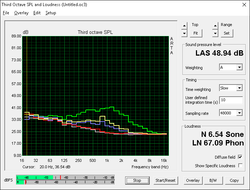
Fan behavior is essentially identical to the GT72S even after the GPU update. The twin fans are always active no matter the workload and will settle in the low 40 dB(A) range when gaming. Thus, while still a bit loud, this is about average for a thick gaming notebook under gaming loads. Turbo Fan will bump fan noise to a steady 52 dB(A), which is prohibitively loud for comfortable gaming without headphones.
Fortunately, fan noise will not pulsate when idling on desktop or when running very low loads like word processing or email.
Noise level
| Idle |
| 32.4 / 32.4 / 32.4 dB(A) |
| Load |
| 39.4 / 52 dB(A) |
 | ||
30 dB silent 40 dB(A) audible 50 dB(A) loud |
||
min: | ||
| MSI GT72VR 6RE-015US GeForce GTX 1070 Mobile, 6700HQ, SanDisk SD8SNAT256G1122 | Asus G701VO-CS74K GeForce GTX 980 (Laptop), 6820HK, 2x Samsung SM951 MZVPV512HDGL (RAID 0) | Acer Predator 17 G9-792-71EF GeForce GTX 980M, 6700HQ, Samsung SSD PM871 MZNLN512HCJH | Alienware 17 R3 (A17-9935) GeForce GTX 980M, 6700HQ, Samsung PM951 NVMe 512 GB | MSI GT72S 6QF GeForce GTX 980 (Laptop), 6820HK, 2x Micron M600 MTFDDAV128MBF NVMe (RAID 0) | |
|---|---|---|---|---|---|
| Noise | 1% | -1% | 1% | -4% | |
| off / environment * (dB) | 28.9 | 29.1 -1% | 30 -4% | 30 -4% | |
| Idle Minimum * (dB) | 32.4 | 29.1 10% | 31 4% | 31 4% | 33.1 -2% |
| Idle Average * (dB) | 32.4 | 31.9 2% | 32 1% | 32 1% | 33.3 -3% |
| Idle Maximum * (dB) | 32.4 | 31.9 2% | 37 -14% | 33 -2% | 37 -14% |
| Load Average * (dB) | 39.4 | 46 -17% | 40 -2% | 38 4% | 39 1% |
| Load Maximum * (dB) | 52 | 47.5 9% | 48 8% | 50 4% | 52.2 -0% |
* ... smaller is better
Temperature
Surface temperatures are cool when idling and during low loads despite the demanding internals since the chassis is quite large. The system does an excellent job at keeping warm temperatures concentrated near the rear ventilation grilles and away from the keyboard and frontal quadrants unlike on the Alienware 17 or most Aorus notebooks. The Predator 17 will run cooler under similar processing loads, but it is also the comparatively weaker system.
(±) The maximum temperature on the upper side is 40.6 °C / 105 F, compared to the average of 40.4 °C / 105 F, ranging from 21.2 to 68.8 °C for the class Gaming.
(-) The bottom heats up to a maximum of 59.4 °C / 139 F, compared to the average of 43.3 °C / 110 F
(+) In idle usage, the average temperature for the upper side is 25.7 °C / 78 F, compared to the device average of 33.9 °C / 93 F.
(+) The palmrests and touchpad are cooler than skin temperature with a maximum of 24 °C / 75.2 F and are therefore cool to the touch.
(+) The average temperature of the palmrest area of similar devices was 28.8 °C / 83.8 F (+4.8 °C / 8.6 F).
Speakers
The 2.1 setup remains unchanged and our microphone measurements show good reproduction at lower frequencies due to the dedicated Dynaudio subwoofer. In comparison, most other Ultrabooks tend to drop sharply at about 250 Hz due to their weaker speakers. Sound quality is good without any distortions or reverberations, but maximum volume is quieter than what the size of the system would otherwise suggest.
Like the Dragon utility, the Nahimic audio utility has also been updated with new features. Users can customize the keyboard backlight to respond to certain onscreen activity or add a directional visual indicator when playing certain FPS titles.
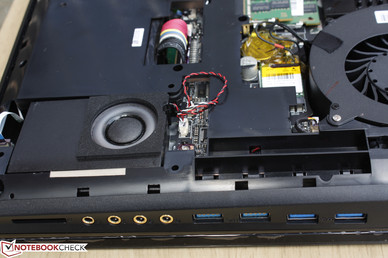
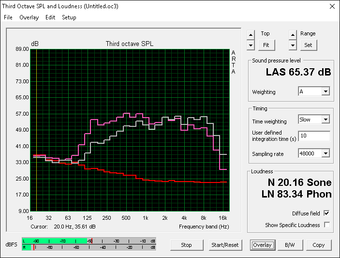
MSI GT72VR 6RE-015US audio analysis
(-) | not very loud speakers (57 dB)
Analysis not possible as minimum curve is missing or too high
Apple MacBook 12 (Early 2016) 1.1 GHz audio analysis
(+) | speakers can play relatively loud (83.6 dB)
Bass 100 - 315 Hz
(±) | reduced bass - on average 11.3% lower than median
(±) | linearity of bass is average (14.2% delta to prev. frequency)
Mids 400 - 2000 Hz
(+) | balanced mids - only 2.4% away from median
(+) | mids are linear (5.5% delta to prev. frequency)
Highs 2 - 16 kHz
(+) | balanced highs - only 2% away from median
(+) | highs are linear (4.5% delta to prev. frequency)
Overall 100 - 16.000 Hz
(+) | overall sound is linear (10.2% difference to median)
Compared to same class
» 7% of all tested devices in this class were better, 2% similar, 91% worse
» The best had a delta of 5%, average was 18%, worst was 53%
Compared to all devices tested
» 4% of all tested devices were better, 1% similar, 94% worse
» The best had a delta of 4%, average was 24%, worst was 134%
Schenker F516 Flex audio analysis
(-) | not very loud speakers (69 dB)
Analysis not possible as minimum curve is missing or too high
Frequency Comparison (Checkbox select/deselectable!)
Graph 1: Pink Noise 100% Vol.; Graph 2: Audio off
Energy Management
Power Consumption
The GT72VR is a demanding system as it draws just over 22 W when simply idling on desktop with Power Saver mode active and on the minimum display brightness. As a fun comparison, this is a few Watts more than the fanless Toshiba Portege Z20t detachable when subjected to maximum load.
Running 3DMark will draw about 152 W compared to 162 W on the recent Asus G701VO and 166 W on the older MSI GT72S. This is particularly noteworthy as the GTX 1070 is noticeably more powerful than both the GTX 980M and GTX 980 Notebook while consuming less power than either when under gaming loads.
Maximum load with both Prime95 and FurMark demands about 204 W against a power adapter (17.0 x 8.5 x 3.5 cm) rated for 230 W.
| Off / Standby | |
| Idle | |
| Load |
|
Key:
min: | |
| MSI GT72VR 6RE-015US 6700HQ, GeForce GTX 1070 Mobile, SanDisk SD8SNAT256G1122, IPS, 1920x1080, 17.3" | Asus G701VO-CS74K 6820HK, GeForce GTX 980 (Laptop), 2x Samsung SM951 MZVPV512HDGL (RAID 0), IPS, 1920x1080, 17.3" | Acer Predator 17 G9-792-71EF 6700HQ, GeForce GTX 980M, Samsung SSD PM871 MZNLN512HCJH, IPS, 3840x2160, 17.3" | Alienware 17 R3 (A17-9935) 6700HQ, GeForce GTX 980M, Samsung PM951 NVMe 512 GB, IPS, 1920x1080, 17.3" | MSI GT72S 6QE-071PL 6820HK, GeForce GTX 980M, 2x Toshiba HG6 THNSNJ128G8NU (RAID 0), IPS, 1920x1080, 17.3" | |
|---|---|---|---|---|---|
| Power Consumption | -9% | 18% | 28% | -6% | |
| Idle Minimum * (Watt) | 22.3 | 28.2 -26% | 14 37% | 12 46% | 14.5 35% |
| Idle Average * (Watt) | 27.3 | 32 -17% | 24 12% | 18 34% | 28.3 -4% |
| Idle Maximum * (Watt) | 30 | 32.6 -9% | 32 -7% | 26 13% | 44 -47% |
| Load Average * (Watt) | 152.2 | 162.2 -7% | 108 29% | 95 38% | 165.5 -9% |
| Load Maximum * (Watt) | 204.2 | 173.5 15% | 164 20% | 188 8% | 214.8 -5% |
* ... smaller is better
Battery Life
Users can expect just over 3.5 hours of actual WLAN usage before the internal battery finally gives way. Runtimes are slightly longer compared to the Asus G701VO despite the ROG having a larger battery capacity, but runtimes are no match for the older MSI GT72S configuration with the GTX 980 partly due to the availability of a manual GPU switch on the older GT72 series.
Charging from near empty to full capacity will take about 2 to 2.5 hours.
| MSI GT72VR 6RE-015US 6700HQ, GeForce GTX 1070 Mobile, 83 Wh | Asus G701VO-CS74K 6820HK, GeForce GTX 980 (Laptop), 93 Wh | Acer Predator 17 G9-792-71EF 6700HQ, GeForce GTX 980M, Wh | Alienware 17 R3 (A17-9935) 6700HQ, GeForce GTX 980M, 92 Wh | MSI GT72S 6QF 6820HK, GeForce GTX 980 (Laptop), 83 Wh | Eurocom Sky DLX7 6700K, GeForce GTX 980 (Laptop), 82 Wh | |
|---|---|---|---|---|---|---|
| Battery runtime | -9% | 38% | 87% | 20% | -30% | |
| Reader / Idle (h) | 5.4 | 4 -26% | 8.8 63% | 12.6 133% | 6.5 20% | 2.6 -52% |
| WiFi v1.3 (h) | 3.7 | 3.4 -8% | 5.1 38% | 7.4 100% | 4.9 32% | 2.3 -38% |
| Load (h) | 1.4 | 1.5 7% | 1.6 14% | 1.8 29% | 1.5 7% | 1.4 0% |
Pros
Cons
Verdict
The star of the show here in the GTX 1070 Pascal GPU. The mobile Maxwell series only scratched the surface of 4K gaming despite the fact that many manufacturers were pushing 4K onto gaming notebooks that clearly couldn't handle most titles on such high native resolutions. The performance leap over the GTX 970M is so large that it makes a serious case for skipping over the 1080p configuration entirely in favor of the 4K UHD option with G-Sync. While we're not sure how the refresh rate of the higher resolution panel compares to the 1080p configuration, we may retest a higher-end GT72VR SKU in the future to provide the data. Pairing Pascal with a 4K panel makes much more practical sense moving forward.
It's easy for users to overlook the many minute changes MSI has brought to its venerable GT72 series because of the launch and performance benefits of Pascal, but this doesn't make them any less important. Users should be aware that when compared to the GT72S, the GT72VR is missing more internal storage options, includes no Thunderbolt 3, and has dropped all graphics switching features. In turn, users get optional 120 Hz refresh rates, 5 ms response times, minor hardware updates, and upgraded software. The system has been scaled back slightly to make room for newer models in the MSI G Series, but it is nonetheless still on equal or better footing than many of its current competitors.
MSI GT72VR 6RE-015US
- 08/11/2016 v5.1 (old)
Allen Ngo


